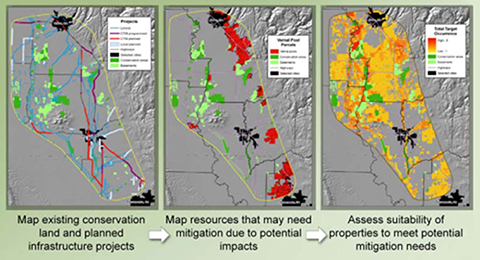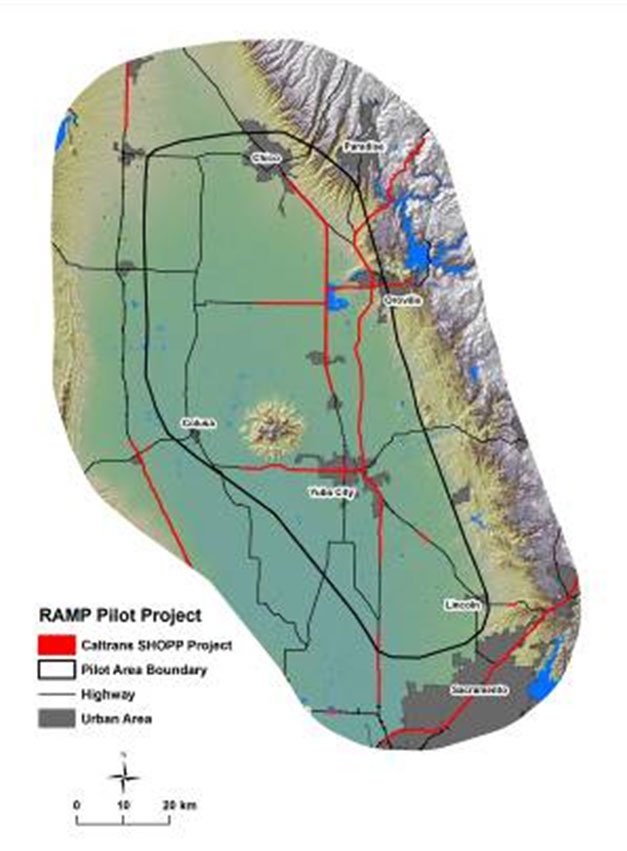Successes in Stewardship
Monthly Newsletter
May 2011
California Uses Advance Mitigation Planning to Link Mitigation to Conservation Goals
What is compensatory mitigation?
All Federal-aid projects, funded pursuant to provisions of Title 23, U.S. Code, that cause loss of wetlands, natural habitat area, or functional capacity are required to restore, enhance, create, or preserve wetlands or wetland buffer areas in compensation. The Endangered Species Act (ESA), California Environmental Quality Act (CEQA), and National Environmental Policy Act (NEPA) can also require mitigation for compliance.
In recent years, transportation agencies across the country have renewed their focus on contributing to State and regional conservation goals through compensatory mitigation activities. By strategically targeting mitigation efforts, agencies can create essential habitat connections or expand existing conservation areas, which will result in more valuable biological resources for wildlife. When agencies plan for mitigation early in the planning process, they have more opportunities to coordinate with other project mitigation efforts to create habitat connections.
Early planning requires the agencies that are planning mitigation to consult with regulatory agencies and identify an overview of mitigation needs. Frequently, transportation agencies do not consider mitigation until the project delivery phase, resulting in missed opportunities for coordinated mitigation, project delays, and elevated costs.
The California Department of Transportation (Caltrans) is pioneering advance mitigation efforts to improve the process and outcomes of mitigation planning in the State. Regional Advance Mitigation Planning (RAMP) brings together State and Federal agencies to identify strategies for anticipated mitigation needs and to create a framework to accomplish the goals of improved mitigation planning. While working on RAMP, Caltrans found the need to identify available mitigation solutions that could meet different types and scales of mitigation needs on a statewide basis. It then began to pursue development of the Statewide Advance Mitigation Initiative (SAMI), which will include a diverse, strategic portfolio of mitigation solutions, such as wetland restoration projects and mitigation and conservation banks. With SAMI, Caltrans will be able to leverage funds for timely mitigation acquisitions early in the planning stages to satisfy requirements for State infrastructure projects, including those identified through RAMP.

Regional assessment steps to implement RAMP in the North Central Sacramento Valley.
(Courtesy of Caltrans)
The Caltrans program offers a valuable case study for other transportation agencies seeking to coordinate mitigation solutions to avoid project delays and improve the quality of mitigation for multiple infrastructure projects. The following sections describe the development of RAMP and SAMI and detail how Caltrans will use these programs to plan regional mitigation strategies and develop a diverse portfolio of mitigation solutions.
Evolution of Regional Advance Mitigation Planning (RAMP)
In the mid-2000’s, Caltrans sought new ways to improve the efficiency and effectiveness of mitigation in relation to its infrastructure projects. Agencies typically mitigate environmental impacts on a project-by-project basis, which often results in a fragmented, inefficient approach to protecting habitats. Mitigation parcels are often small and isolated, offering less conservation value.
Caltrans has usually addressed mitigation solutions during the project-delivery phase, which can add cost and delays to transportation projects. Project delays can occur when mitigation is not available or is incomplete. In these cases, Caltrans has often acquired additional support funding to complete mitigation.
Building on ideas from programs in North Carolina, Florida, and Colorado, Caltrans convened a two-day Building Conservation to Infrastructure Summit in July 2008 to discuss potential improvements to the current mitigation system. The summit included several State and Federal resource and regulatory agencies, such as the California Department of Fish and Game (CDFG), California Department of Water Resources (DWR), U.S. Army Corps of Engineers (USACE), Environmental Protection Agency (EPA), Fish and Wildlife Service (FWS), and National Marine Fisheries Service (NMFS). The summit discussions led to the creation of RAMP, which is a strategic mitigation and conservation-planning program designed to:
- Identify mitigation solutions for infrastructure projects early to prevent project delays and take advantage of lower land prices.
- Strategically locate mitigation sites that will connect habitats in areas of environmental importance.
By engaging a diverse group of resource and regulatory agencies early, the RAMP working group was able to successfully develop a program that considered agencies’ different needs. Caltrans, CDFG, FWS, NMFS, and DWR signed a Memorandum of Understanding (MOU) indicating that they would work collaboratively to develop RAMP and to initiate implementation of regional mitigation that would be both well coordinated and would occur in advance of infrastructure-project impacts. Caltrans is using planning funds to develop and implement RAMP and each signatory agency is providing staff in-kind contributions. USACE and EPA signed separate letters of support for the program due to sections of the MOU that might have conflicted with the procedures of their respective agencies.

Map of pilot regional assessment area in the North Central Sacramento Valley, showing Caltrans projects. SHOPP = State Highway Operation and Protection Program.
(Courtesy of Caltrans)
The RAMP working group developed a model using MARXAN, a systematic reserve-design and conservation-planning software, to identify potential conservation and mitigation sites. The MARXAN model is meant to find and prioritize strategic areas for mitigation that will maximize biological benefit and conservation value to target species, habitats, and aquatic resources. The model gives high priority to parcels that foster connections among habitats and create larger conservation areas. For example, the model prioritizes parcels with the potential to both link habitats and conserve bodies of water over parcels with water conservation potential alone.
The working group will begin implementing RAMP through a pilot regional assessment in California’s North Central Sacramento Valley. The group chose Sacramento Valley because of the presence of a number of species that require mitigation and the variety of infrastructure projects that Caltrans and DWR are planning for the region. The working group used the MARXAN model to analyze the type and approximate acreage of mitigation needed for these projects. It also has begun to analyze acquisition potential for specific mitigation parcels in the area.
The pilot will help the working group to identify effective RAMP processes and to refine the program. The working group is also developing performance measures to assess the effectiveness of RAMP at a programmatic level. While the performance measures have not been finalized, they are likely to include permitting times and reduction in temporal loss of habitat.
Coordinated Review Through the Statewide Advance Mitigation Initiative (SAMI)
To ensure that Caltrans would have funds to successfully implement mitigation solutions identified through RAMP and to develop advance mitigation solutions on a statewide basis, Caltrans and several agencies from the RAMP working group reconvened in 2010 to develop the SAMI. Caltrans signed an MOU with CDFG, USACE, EPA, FWS, and NMFS to establish SAMI. Caltrans is developing the SAMI framework, which will guide its work with regulatory agencies in developing a portfolio of mitigation solutions for its compensatory mitigation projects in advance of project delivery. Ideally, SAMI will include mitigation solutions for other State infrastructure agencies, such as the California High-Speed Rail Authority and, potentially, DWR.
SAMI will consist of a portfolio of mitigation solutions at a landscape scale, including but not limited to mitigation and conservation banks, in-lieu fee programs, and permittee-responsible mitigation, in which the agency applying for the development permit creates the required mitigation offsets. The range of mitigation options will provide flexibility to infrastructure-project teams in search of timely, cost-effective mitigation solutions. The SAMI working group plans to conduct outreach and discussions with mitigation bank sponsors and conservation groups in the spring and summer of 2011 to obtain other ideas regarding mitigation strategies.
The SAMI working group plans for CDFG to have primary responsibility for planning and implementing SAMI, although each of the signatory regulatory agencies will also be involved by identifying areas that will meet their conservation goals. CDFG will develop the portfolio of mitigation solutions on the basis of a broad assessment of potential mitigation needs from Caltrans projects and on mitigation requirements from the regulatory agencies in the SAMI working group. At this time, Caltrans is beginning to work on a draft assessment of mitigation needs and on developing the work plan and scope of work with CDFG.
In addition to the draft assessment and work plan, the SAMI working group also must develop the accounting procedures. Caltrans would like to establish a revolving fund for planning and implementation activities of mitigation projects, both of which will be eligible for reimbursement from the Federal Highway Administration (FHWA). The SAMI working group is identifying accounting procedures to manage this reimbursement protocol and also to make the program available to non-Federal agencies that conduct large-scale infrastructure projects requiring environmental mitigation. These procedures will be important in ensuring that non-Federal projects do not use Federal funds for mitigation. Allowing non-Federal agencies to participate in SAMI will increase the amount of coordinated mitigation land and solutions, thereby improving the likelihood of reaching conservation goals. Depending on funding availability, mitigation implementation may first occur on a regional level, with participating agencies working with a limited number of projects and later moving to a statewide level once the agencies have secured funding for a larger number of projects.
Next Steps
Both RAMP and SAMI have accomplished many of the goals outlined in their respective MOUs, due to early involvement and clear communication among the agencies in the working groups. Although both working groups have made progress in developing their programs and frameworks, the programs are in their early stages and the groups plan to grow them further by connecting them with other State agencies. Working-group representatives are reaching out to agencies such as the California High-Speed Rail Authority and the Department of Corrections, both of which are planning large-scale infrastructure projects that will require mitigation.
As more agencies participate, the State can expand the programs into a comprehensive system for landscape-scale mitigation projects. Greater application of the RAMP and SAMI frameworks will help California and Federal agencies link mitigation to their broader conservation goals, resulting in increased effectiveness of compensatory mitigation.
Look What’s New!
- Together with the Federal Transit Administration and the American Planning Association, FHWA will host a webinar featuring award-winning projects from the 2010 Transportation Planning Excellence Awards’ Livability/Sustainability and Transportation and Land Use Integration categories. The webinar will take place on Wednesday, May 11, 2011, from 1:00 to 2:30 p.m. ET.
- FHWA will host a webinar, “Eco-Logical and Wildlife Connectivity: Concepts in Innovative Planning,” on Tuesday, May 24, 2011, from 1:00 to 2:30 p.m. ET.
- FHWA recently released an update to prior guidance on the metropolitan transportation planning requirements to be addressed prior to making decisions under NEPA. For more information, read the distribution memo.
- FHWA published Guidance on Using Corridor and Subarea Planning to Inform NEPA as part of the Every Day Counts and Planning and Environment Linkages initiatives. This guidance provides information to transportation planners and environmental practitioners on how to use corridor and subarea planning to bridge the transportation-planning and NEPA processes, as authorized in 23 CFR Part 450.
- FHWA’s ESA Webtool has been updated and relocated to www.environment.fhwa.dot.gov/esawebtool. The updated site maintains all of the features of the previous site and some exciting new functions. The Webtool includes a National Biological Assessment Template, individual project file cabinets, extensive help resources, a training site, and a desktop icon for easy access. Visit the site to learn more about how you can benefit from using this tool. For additional information, please contact:
Mary Gray
FHWA
Office of Project Development and Environmental Review
(360) 753-9487
Mary.Gray@dot.gov
Contact Information
Mary Gray
Environmental Program Specialist
FHWA Office of Project Development and Environmental Review Division
(360) 753-9487
mary.gray@dot.gov
Andrea Williams
Senior Mitigation Coordinator
Biology and Technical Assistance Office
Caltrans
(916) 653-8566
andrea.williams@dot.ca.gov
Successes in Stewardship is a Federal Highway Administration newsletter highlighting current environmental streamlining and stewardship practices from around the country. Click here to subscribe.

